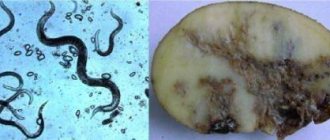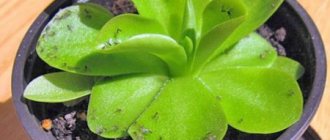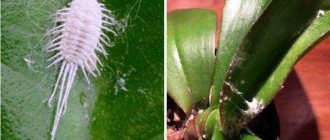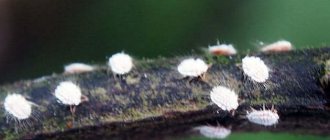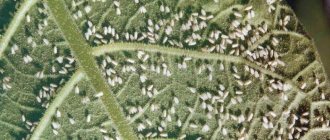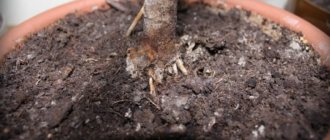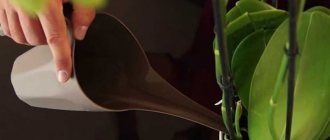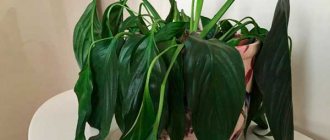There are thousands of types of parasites that significantly spoil the lives of people and animals. The most dangerous and annoying types of insects are considered to be basement or earthen fleas.
Blood-sucking parasites multiply quickly and survive in almost any conditions. Therefore, it is quite difficult to destroy them. But with the right, long-term, comprehensive approach, it is possible to get rid of parasites.
To do this, you need to disinfect your home using professional and folk remedies.
Ground fleas: basic information
What they look like
The parasite is small in size - up to 3 millimeters in length. The body is flat, brown. It has three pairs of limbs, of which the hind pair is especially developed. Thanks to such long legs, the earth flea moves very quickly, jumping 50 cm in length and height. The legs have a large number of bristles, which securely hold the insect on clothing, human shoes, or animal fur. Because of this ability, the insect can migrate long distances, move from the street to the house, and climb to the upper floors of multi-story buildings.
What do they eat?
Ground fleas feed on human blood. In the absence of a person, they can also bite domestic animals, livestock, and birds. The flea can smell the blood and sweat of a potential victim 2–3 meters away. To function normally, an adult insect needs to feed once every 2–3 days, sucking 1 ml of blood at a time. The parasite can make several punctures in the skin until it finds the place where the capillaries and vessels are closest to the surface.
How do they reproduce and how long do they live?
The earth flea lives on average about two years, which is longer than the lifespan of most insects. A flea produces approximately 500 new insects during its life. A sexually mature female flea becomes capable of reproduction only after feeding. Two days after saturation, she lays up to 50 eggs, from which larvae appear after 10 days. They are very afraid of daylight, so they hide in secluded places, where they grow a cocoon around themselves for one to three weeks. They can stay in this cocoon from 7 to 200 days, after which the cocoon turns into a flea.
Tips and important points
- There are no baits for fleas, since they drink blood. Therefore, most often only sprays/aerosols, powders/suspensions are used, which can penetrate the body of parasites.
- Larvae can feed on insecticides, so it is much more effective to use dusts to kill them.
- It is worth choosing not one drug, but several at once - this will make the fight more effective.
- Pyrethroids or organophosphates can be used as the main substance in the preparations. The second substances act quickly on insects, but the effect cannot last as long as in the case of pyrethroids.
- Powders are most often poured where they can remain for as long as possible. It is much more reasonable to poison insects in basements with them.
Choosing a drug!
Always follow this procedure: study the label of the drug, find out the active substance used in it, study its properties, and only then start poisoning fleas.
Conclusion
With these simple methods you can quickly get rid of fleas in your apartment. Traditional methods have been time-tested, but you should resort to them only in case of prevention. It is much easier to purchase a special product that will help you get rid of this unpleasant problem as quickly and permanently as possible.
How do you like the article?
Habitats
Ground fleas, as the name suggests, live in the ground. The quality of the soil does not matter to them, but in sand and loose soil they are more mobile. For the winter, they burrow to a considerable depth - up to 20 cm, pupate and thus wait out the frosts. When it gets warmer outside, fleas come to the surface; there are especially many of them after rains and with the onset of heat.
Most often they can be found in the basements of apartment and private buildings, industrial or commercial premises. Pests prefer abandoned spaces with unsanitary conditions, but can settle anywhere, even where they keep order. They love warm rooms with high humidity.
Since earth fleas feed on blood, they move around in search of prey. Most often, residents of the first floors of high-rise buildings suffer from them.
Traditional medicines against parasites
Folk remedies are often used to get rid of fleas. You shouldn’t rely too much on them, as they mostly have a deterrent effect. The most popular plants: mint, wormwood, tansy, bay leaf, chamomile. Fresh or dry twigs are laid out indoors, you can prepare decoctions and treat floors, furniture, and walls with them.
Ammonia, vinegar, and aromatic oils are added to the water for washing floors. Placing citrus peels around the perimeter of the house will help repel bloodsuckers. Garlic has a pronounced repellent effect, and in combination with brewer's yeast, it causes parasites to quickly leave their habitats.
Are bites dangerous for humans?
Earth flea bites are painful. Immediately after the insect has pierced the skin and drunk blood, a red spot appears in this place, its size reaches 2 cm. It can swell and rise above the skin. The most unpleasant symptom is unbearable itching. It can be muffled by smearing the bite site with pharmaceutical anti-allergy gels. If the body continues to itch, it is necessary to treat the skin with antiseptic agents, for example, chlorhexidine or miramistin. This will prevent infection from entering the wounds.
What is the danger:
- If there are too many stings, a person may experience anaphylactic shock. At the first signs of this most dangerous condition, you should immediately consult a doctor.
- Allergic reaction. There are people with a high tendency to allergies. They may develop pulicosis due to flea bites. Children suffer from it more often. The bite sites are very itchy, irritated, and hemorrhage occurs under the skin - purple.
- Inflammatory phenomena and processes. An infection can get into the puncture, causing inflammation to develop, and the bite turns into an abscess that needs to be treated with iodine. It is better to seek treatment from a dermatologist.
- Dangerous diseases whose pathogens are carried by fleas: encephalitis, plague, listeriosis, tularemia, typhus, salmonellosis, hepatitis, as well as helminthiasis of various types.
First aid
Most often, fleas bite on the ankles, ankles, and feet. The bites may not be visible, but there is no escape from the itching. A compress will help relieve discomfort; you can also anoint the skin with antihistamine gels. If there are no symptoms other than itching, that is enough. Over time, the itching will subside. But if signs of intoxication or allergies appear, you should immediately consult a doctor.
How to help a child with flea bites
Children are much more likely to experience allergic reactions. The spots may merge into one large spot. Itching is relieved, as in adults, with cold compresses. It is necessary to ensure that the child does not scratch the affected areas. If there are a lot of bites, it is better to seek medical help, since not all antihistamines to relieve symptoms can be taken by children. Only a doctor can prescribe a specific drug and dosage.
Industrial means of control for home and apartment
Effective methods of baiting insects include industrial means. Aerosols, sprays, suspensions, powders cause paralysis of the bloodsucker's nervous system and its death.
Dangerous for insects and relatively safe for humans
The composition of an effective finished drug should include paralyzers of the nervous system of parasites. These components include peritroid and organophosphorus substances, which have a strong unpleasant odor.
Table: drugs for killing parasites
| Name of active component | Effect of the drug | Features of use |
| Pyrethrins | They act on the nervous system of insects and lead to repeated and extensive nerve ruptures. | Pyrethrins are used to kill ticks, fleas, lice and mosquitoes. Pyrethrin-based products are applied directly to the animal. Safety: The potential for toxicity in animals is very low, but possible. Symptoms of poisoning (salivation, trembling and vomiting) disappear after 24 hours. |
| Pyrethroids | Synthetic components of pyrethrin. They act more slowly than natural pyrethrins, but have a longer lasting effect. | Used for the production of products against fleas, lice and ticks (in sprays and shampoos). Permethrins are soluble in oils, but not in water. |
| Imidacloprid | Acts on the nervous system of insects, blocking nerve receptors. This kills fleas but has no effect on ticks. | Use once a month as a topical flea insecticide for cats and dogs. It is a fairly safe substance, but some pets may develop sensitivity to it. |
| Fipronil | Paralysis of parasites. | Use once a month as a topical insecticide for cats and dogs to control fleas and ticks. Some pets may experience temporary sensitivity at the site of application. |
| Metaflumizone | Paralysis and death of fleas. | Apply externally once a month. Has no effect on ticks. Some animals may experience temporary sensitivity at the site of application. |
Powders and sprays
- Among household insecticides, Dichlorvos spray remains popular. This is a drug with a pungent odor and is harmful to the health of people and animals. You will have to leave your home during processing. You should prepare yourself for repeated treatment with the drug. For a two-room apartment you will need ten cans.
- More economical is the spray solution made from Gett concentrate and its domestic analogue Gett. A couple of bottles are enough. The product is effective against any insects.
- The insecticide powder “Dust” will make your apartment uninhabitable for parasites. After its application, the treated area is not washed for several days. The longer the product remains on the floor, the fewer bloodsuckers survive.
- Slightly less effective, but budget-friendly insecticides are Pyrethrum, Finaxin, and Clean House.
Methods of disposal
When there are not too many fleas in the apartment, chemical insecticides help against them. If you follow the manufacturer's recommendations, they can quickly kill all insects in the room without causing harm to household members. If for some reason it is impossible to use chemicals, you can use folk remedies to remove fleas. But we must remember that most of them only repel insects, but do not kill them, much less destroy eggs and cocoons with larvae.
The biggest problem with earth fleas is that they come into apartments and houses again and again from the street, basement, and common areas in apartment buildings. Because of this, ordinary household means of bullying simply do not work and do not give lasting results. This is why you have to call professional exterminators to completely remove fleas. This is the most effective method of insect control. You can process an object of any size. For example, in residential buildings they treat not only the apartment, but also stairs, basements, attics and other places where parasites can hide. Professionals use special equipment and poisonous agents that act not only against adults, but also destroy eggs, pupae and larvae.
Reviews
Anna Petrovna, 37 years old, Perm
“One day there were fleas in our apartment. Only me was bitten; fortunately, my husband and children did not have any marks, and nothing itched. But we immediately thought about how to remove it, since I was pregnant then - that is, chemicals could not be used. My mother-in-law helped - she collected wormwood near her house. One bunch was placed directly in the sofa drawer, only three days - no bites. Therefore, I recommend wormwood, and you need to put it where the fleas were most noticed.”
Oleg Anatolyevich, 26 years old, Moscow
“It's quite difficult to get rid of these parasites! And especially - to block their access to the house. That's why. If the problem is large-scale, and even in an apartment building, then it is best to solve it together with your neighbors! It will be cheaper and faster”
Folk remedies against earthen fleas
Traditional methods of control have been used for many years; they were effective before the advent of chemicals and continue to be used to this day. It is important to understand that many of them have lower effectiveness and therefore require repeated or regular use. You also need to remember that some of them can be hazardous to health.
Soda with salt
They are mixed equally, then this simple and safe mixture is sprinkled on all surfaces with pile. Fleas do not live on smooth surfaces; they hide in carpets, upholstered furniture, on dog or cat bedding, etc. All such things in the house should be completely covered with this soda-salt mixture and left for 10 hours. Then everything needs to be vacuumed very thoroughly to remove salt and soda, and at the same time dead fleas. This procedure will not kill all the fleas in the house the first time, so it is repeated after a couple of days.
Pine aromas
They are unpleasant to fleas and many other pests. Twigs of coniferous trees should be placed around the house and regularly replaced with fresh ones. Drying pine needles are no longer so fragrant. This product is not intended to kill insects, but only to repel them.
Tansy and wormwood
Two plants that are used to control many insect pests. They have a very strong specific smell that fleas cannot stand. Bunches of wormwood or tansy were always mixed in houses or premises where livestock lived. These plants contain a high content of essential oils, which reliably repel insects.
You can prepare a decoction of wormwood and tansy by taking two tablespoons of dry crushed plants (you can take any parts: flowers, leaves, stems), add two glasses of water, bring to a boil in a water bath, then leave for 4 hours to make the decoction insisted. This decoction is used to spray or wipe surfaces.
They also use wormwood tincture, which can be purchased at a pharmacy or veterinary clinic. The tincture is used to treat the fur of dogs and cats to remove fleas.
Other plants
Not only wormwood and tansy are unpleasant to insects. Thyme, mint, eucalyptus, geranium and other plants with a strong aroma can be used to repel. It is important that they are not dried out or wilted, as the aroma that only fresh plants exude scares insects.
Turpentine and kerosene
Fleas do not eat anything other than blood, so it is impossible to poison them, like ants, for example. You can only act against them through a breathing apparatus. Strong, pungent odors repel them. Turpentine and kerosene have a very pungent and unpleasant odor. They are sprayed where fleas may be hiding, the amount of liquid should be sufficient to penetrate, for example, into cracks in the floor or walls. But it is important to remember that these are flammable liquids, which can also negatively affect human health. Therefore, it is necessary to observe safety precautions when working with them. It is also important, after removing fleas using this method, to thoroughly wash the surfaces to remove any remaining product without a trace.
Ammonia
It has a very strong odor that fleas cannot tolerate. You can simply pour ammonia into cracks in the floor or walls, behind baseboards and other secluded places where parasites hide. Second use option: add 20 drops of ammonia to five liters of water and treat all smooth surfaces with this solution or spray it on upholstered furniture, carpets, etc. When washing dog bedding, add a few drops of ammonia to the water.
Essential oils
These are not the most effective means of removing parasites, but they can help keep them out of your home. Oils with strong odors are best used not to combat parasites, but to prevent the appearance of fleas in the house. Lavender, lemon balm, cloves, and wormwood are suitable for this purpose. Attention, you must remember that in high concentrations, odorous oils can cause headaches and other unpleasant reactions in people.
Garlic and brewer's yeast
Ten parts garlic is mixed with one part yeast. It turns out a strongly odorous mixture that is laid out in places where fleas have been noticed. Usually a day is enough for the pests to disappear. Attention: Under no circumstances should this mixture be made available to children or pets.
Borax
This product is a salt of boric acid. It is safe for humans and is even used as a cleaning agent. Borax in small concentrations is also not dangerous for pets. But almost all insects cannot tolerate borax. It is sprinkled on upholstered furniture, carpets, and smooth surfaces. Fleas carry these small crystals throughout the apartment, including taking them to hard-to-reach places, where they die.
How to remove fleas from your home forever with minimal cost
To get rid of flea infestations, special insecticidal chemicals are used in the house:
- aerosols such as Dichlorvos, Combat, Raptor;
- special concentrated substances: Cypermethrin, Tetramethrin, Permethrin, etc. They need to be diluted with warm water, poured into a spray bottle, and sprayed throughout the apartment;
- powder products: Phenaxin, Clean House.
These tools must be used, since without them it is impossible to solve the problem. After them, you need to use traditional methods of ridding your apartment of parasites; they will play the role of preventive measures.
Removing fleas with insecticides
If folk remedies do not help, if there are a lot of fleas in the house, you should resort to professional remedies. Some of them can be purchased and used independently, for example, room treatment products produced by the Medilis Laboratory, such as: Permifen, Malathion, Super, Cyper, Neo, Chlorfenapyr Duo. Each of them must be used in strict accordance with the instructions. These are concentrates for the preparation of working solutions, which are sprayed or applied by wiping. Almost all of the drugs presented above are available in 50 ml bottles, convenient for purchase by the public and for use in everyday life. If all the rules are followed, one treatment is sufficient; in particularly advanced, complex cases, the procedure is repeated until complete destruction.
How to get rid of fleas in a suburban area
Fleas can get into the garden, suburban area, even into the yard. To get rid of them, you need to scatter wormwood branches throughout the area. Chemicals will not be very effective in this case. An exception is special insecticidal agents for open areas. If fleas appear on fruits, then you cannot poison them - you will have to wait for the harvest, and only then treat the problem area.
How to prepare for disinfestation
An apartment, room, house must be prepared for the application of insecticides. Any pests do not like cleanliness and order. First you need to sort out the rubble, take out the trash, remove lying around, vacuum upholstered furniture and carpets. It is advisable to wash or dry-clean textiles. A steam generator can be used to treat non-smooth surfaces. Smooth surfaces should be washed, paying attention to the top panels of cabinets, lamps and other places where dust can accumulate.
What danger do grass fleas pose?
Grass flea beetles (wood flea beetles) pose a serious threat to fruit trees and vegetable crops. With the end of winter, these pests begin an active period of life. Insects damage young blossoming leaves of fruit crops, drink plant juice, and interfere with the development of stems and young shoots.
The greatest danger is represented by the larvae of grass fleas - nymphs. Nymphs are very voracious and inactive. The digestive system of nymphs is not able to absorb all the substances entering the body. During active feeding, the waste products of the larvae are a sticky sugary liquid covering the surface of the leaves and stems. This liquid attracts aphids, which further damage the plant. The sweet coating, called “honeydew,” serves as a breeding ground for sooty fungus. These parasitic microorganisms cover the tips of young shoots and unopened buds with a black coating. As a result of such a strong impact, the plant dries out greatly and stops bearing fruit.
Grass fleas
If grass fleas appear in the house and feed on seedlings on the windowsill or flowers in pots, then these plants can become infected with fungal spores, especially in conditions of high humidity and elevated temperatures.
Most often, apple trees, sweet varieties of pears, plums, strawberries, carrots and cereals suffer from grass fleas. Among indoor plants, the most vulnerable are those species that have soft, succulent stems and young blooming buds.
Warm-blooded animals and humans are not victims of these parasites, so any pet is not in danger. The parasite's mouthparts are not adapted to pierce the skin of mammals and are not capable of biting.
If there are children or pets in the house
When treated for fleas, children and animals must be taken away from the house and not returned until disinfestation has been completed completely, including cleaning the premises. Please also note that all flea control products must be stored in places where children and animals cannot find them.
Animal handling
If the house is infested with fleas, then most likely they live on the bedding of a dog or cat, and may also be on their fur. In parallel with the treatment of the premises, pets must also be treated. For this purpose, special veterinary products are used.
Preparing for home treatment
In order for disinfestation to be as effective as possible, it is necessary to clean the living space and prepare it as much as possible. Before treatment, children and animals must be removed from the house.
You also need to place personal belongings, children's toys, and personal hygiene items in closets. Before eradicating earth fleas from the house, you should cover furniture, household appliances, and paintings with film. Dishes and food must be put in the refrigerator or cabinets.
Furniture should be moved away from the walls, which will allow you to treat hard-to-reach places. Bedding should be boiled and then ironed.
The procedure to help get rid of basement fleas involves the use of chemicals.
Therefore, before carrying out the treatment, you must wear a special protective suit, gloves, headscarf, and goggles.
Prevention
Once you have managed to get rid of earthen fleas, it is important that they do not appear again. To do this, it is important to maintain cleanliness, prevent clutter and debris, and carry out wet cleaning and ventilation. You can wash the floors from time to time with water with the addition of a few drops of ammonia. The threshold of the house can be treated with a small amount of kerosene or turpentine, but remember that these substances are very flammable and can be dangerous. You can use essential oils and fragrant herbs to scent your home and repel insects. Sachets with drops of oil or bunches of plants are placed throughout the house.
The most important thing: if at least one bite appears on the body of one of the family members, you need to immediately start fighting earth fleas. This is much easier to do at a time when there are not too many insects.
Methods of controlling parasites
General wrestling rules:
- Block all ways for insects to enter the house.
- Do wet cleaning.
- Clean furniture, carpets and other fleecy surfaces with a vacuum cleaner. You can clean walls up to a height of 1.5 m.
- Wash bedding in hot water and iron after drying.
- Seal food products, or better yet, put them away.
- Remove animals from the house and remove indoor plants.
- Treat bedding for animals with heat.
Only after this can disinfestation be carried out in the house.
Chemicals
Before purchasing any insecticide, you should make sure that it is effective against fleas. Before starting to treat the room, it is recommended to protect yourself with clothing, a mask, and gloves. All premises should be treated without exception. Especially focus on baseboards, furniture, possible cracks - places where massive accumulations of parasites are possible. At the same time, you need to treat the basement, because it is often the source of flea infestation in the house.
After the procedure, leave the room for several hours. Then the house needs to be ventilated and work surfaces washed. One-time chemical treatment does not guarantee quick destruction of pests. Larvae and pupae may remain, against which the poison is not effective. Therefore, after some time, disinsection should be repeated.
Chemicals can be produced in several forms: concentrates, aerosols, powders. The concentrates are diluted with water and then sprayed onto surfaces.
The most effective concentrates for fleas:
- Lambda Zone;
- Digital;
- Agran.
Aerosols are more convenient to use because they do not require dilution. They are easy to use, but compared to concentrates they are less economical; treating a large room with aerosols will cost more.
Popular aerosols:
- Dichlorvos;
- Raptor;
- Raid;
- Battalion commander
Powders (dusts) kill larvae in addition to adults. To quickly kill earth fleas, it is better to combine the use of powder with other means.
Flea powders:
- Clean house;
- Phenaxin;
- Ecokiller.
At the same time, pets need to be treated for fleas. There are many tools for this in pet stores:
- Drops (Hartz, Frontline);
- Flea shampoos (Beaphar, Leonardo, Doctor Zoo);
- Emulsions (Butox 50) and others.
Folk recipes
If the use of chemicals is unacceptable for some reason, you can turn to folk remedies for help. It should be borne in mind that they do not provide a 100% guarantee of quickly getting rid of fleas.
Several recipes:
- Pour 2 parts of wormwood, 1 part each of tansy and eucalyptus into a thermos. Pour 1.5 cups of boiling water and leave for 24 hours. Spray the house with the strained broth using a spray bottle.
- Mix 1:1 soda and salt. Sprinkle the mixture around the house. Before doing this, carefully block all access routes for insects into the room.
To repel fleas, you can use pads filled with pine needles. They just need to be placed around the house.
Drugs that cause paralysis in insects
There are a number of drugs that penetrate the chitinous membrane of pests. After the active substances enter the insect’s body, its nervous system is damaged. One of the effective drugs with a paralyzing effect is Tsifoks.
The drug is available in the form of a clear liquid with a pungent odor. Cypermethrin is the main active ingredient. The insecticide is economical: a liter container is enough to treat a large apartment several times.
Attention! The product is very toxic! Used for treating premises and summer cottages. The insecticide is available in glass bottles of 50, 500 and 1000 milliliters.
Another option for killing fleas is Sinuzan spray. A powerful professional product used by exterminators. Users note the rapid destruction of fleas - within one hour. The drug copes with adults, their eggs and larvae. Using the product requires strict compliance with safety measures. After treatment, leave the room for several days.
When do fools appear?
A small number of springtails are almost always present in the soil of houseplants. When their population is small, podurs are not noticeable and do not interfere with the plant in any way. But as soon as the gardener begins to overwater the flower, thus provoking the creation of a nutrient-rich environment for springtails, the springtails enter the stage of active reproduction, their numbers are actively growing, and now insects become a problem for the plant and the gardener.
[!] Podura for the gardener is always a signal that watering should be reduced!
If you overwater a plant and the water stagnates on the surface of the soil, forming silt, expect uninvited guests.
The optimal habitat for springtails is moist soil and parts of the plant that begin to rot from waterlogging. The products of rotting are the best food for fools.
Very often, podurs appear on plants that constantly need a moist environment (pallets with water, moistened soil), for example, on cyperus. In such cases, you should not reduce watering and deprive the plants of their usual living conditions, and you need to fight the fools with the help of insecticides or folk remedies.
Damage from fools
Poduras, especially small specimens, cause virtually no damage to the plant. The only exception is young seedlings of Uzambara violet (Saintpaulia). Moreover, only the largest individuals can cause damage to the violet.
Another possible harm from these insects is in the case of a large population and low room temperature. Under such conditions, plants slightly damaged by durs become very vulnerable to various infections and rots.
That, perhaps, is all the trouble that springtails can cause.
What to do with bites?
If, as a result of constant bites, you have developed severe inflammation and dermatitis, there is only one way - to the hospital. You should not self-medicate, as it may well even end in purulent phlegmon! If everything is not so scary, then bites can be treated with 70% medical alcohol. Exactly 70%, since a concentration of 96% not only burns the skin, worsening the process, but also has a worse effect on the pathogenic microflora that has infested the bite sites. You should not use colognes either, as the essential oils they contain can contribute to the development of an allergic reaction. You can get rid of severe itching by using the drugs “Diphenhydramine”, “Tavegil”, “Suprastin” or other drugs with a pronounced antihistamine effect.
bubonic plague.
Features of the view
Grass fleas are easily confused with those parasites that appear in animals. They are dark brown, almost black in color and small in size. The length of the body of an adult does not exceed 3 mm. The Latin name of this species is Psyilidae. They belong to the family Hemiptera. The grass fleas in the photo are very similar to the common black cat fleas that are found on cats.
This type of parasite is distributed almost throughout the planet.
The grass flea has 2 wings on its back. The insect has two pairs of short legs. The rear ones are designed for powerful jumps. Parasites can safely jump to a height of up to 0.4 meters. The existing claws on the paws help the flea to securely attach to the animal’s body and move calmly.
There are 3 stages of the flea life cycle:
Unlike garden pests, psyllids, which feed on plant sap, use human or domestic animal blood as a food source. The most popular habitat is tall grass and upper layers of soil.
Why do midges appear on indoor flowers?
Midges in flower pots do not appear out of nowhere. Most often, people themselves infect their green pets. There are three main reasons why midges appear in pots of indoor plants:
- Pests enter the house along with the new plant. Flower shops rarely maintain the correct conditions. Plus, new plants from different parts of the planet appear there regularly. All this creates an excellent background for the spread of flower midges. Therefore, when you buy a new flower and bring it home, quarantine it away from other plants. Watch carefully to see if your new pet is sick. If all is well, after 2-3 weeks, move the pot to a permanent place.
- Insects are brought into the house along with purchased soil for replanting plants . In theory, flower soil that is sold in stores must undergo a disinfection procedure. But, unfortunately, manufacturers do not always treat this in good faith. Therefore, the soil often contains larvae and eggs of various pests. Experienced gardeners advise disinfecting the soil themselves before replanting. You can also freeze it by keeping it on an open balcony for several hours.
- Midges enter the house through open windows in spring and summer. The warm season is the time for migration and reproduction of insects. It’s easy to “catch an infection” with an open window. In summer, you need to inspect flowers more often, since the risk of infection is greater.
But it’s not enough to just bring insects or their larvae into the house; you also need to create favorable conditions for them to reproduce. And here the fault of the flower growers is obvious.
Untidy plants, constant overflowing, stagnation of water in the pot, lack of drainage, incorrect temperature conditions and air humidity - all this causes a sharp increase in pest populations.
Midges hatch from eggs, give birth to new offspring and very quickly move from plant to plant.
IMPORTANT! Follow the rules for caring for plants so as not to create favorable conditions for pests to reproduce.
